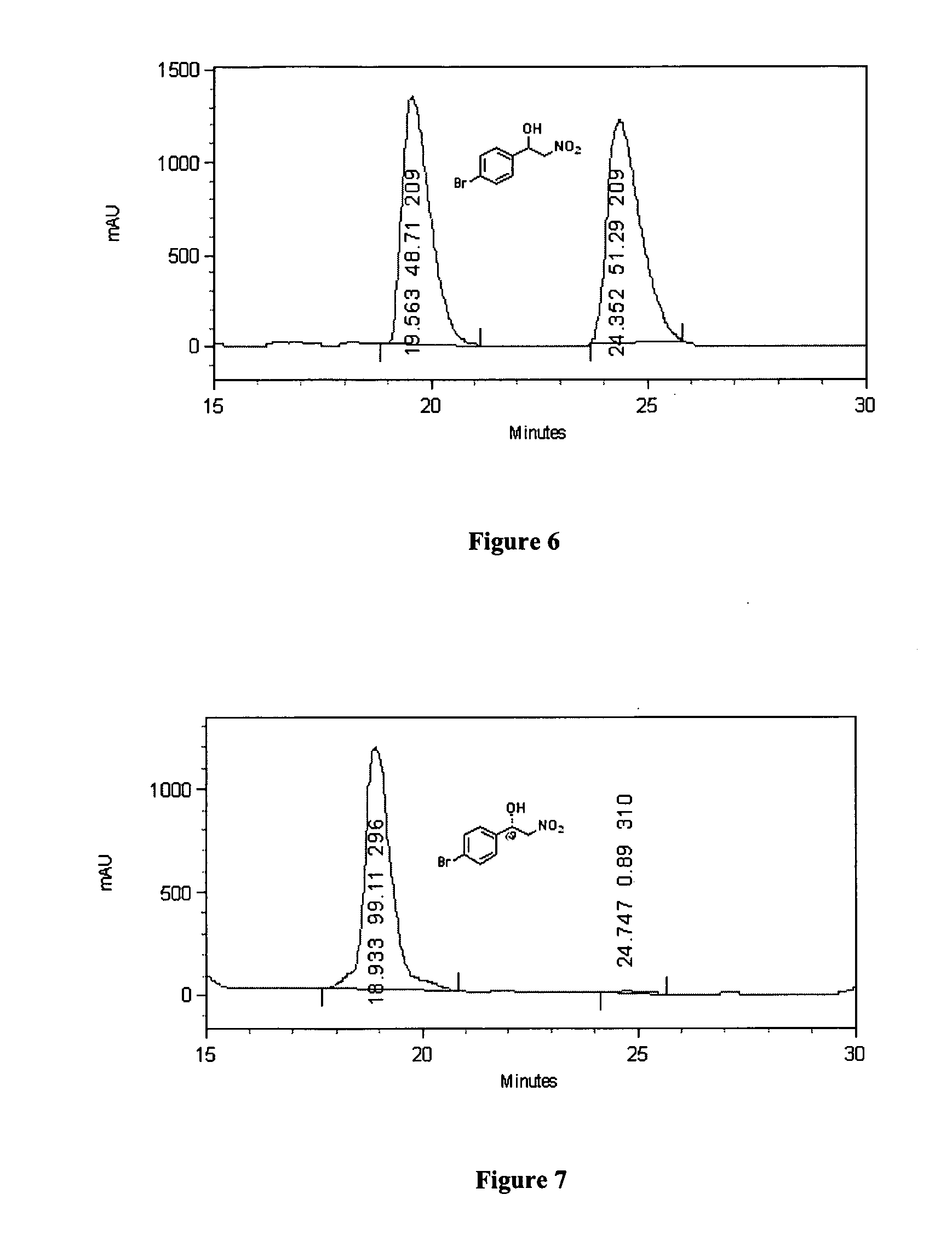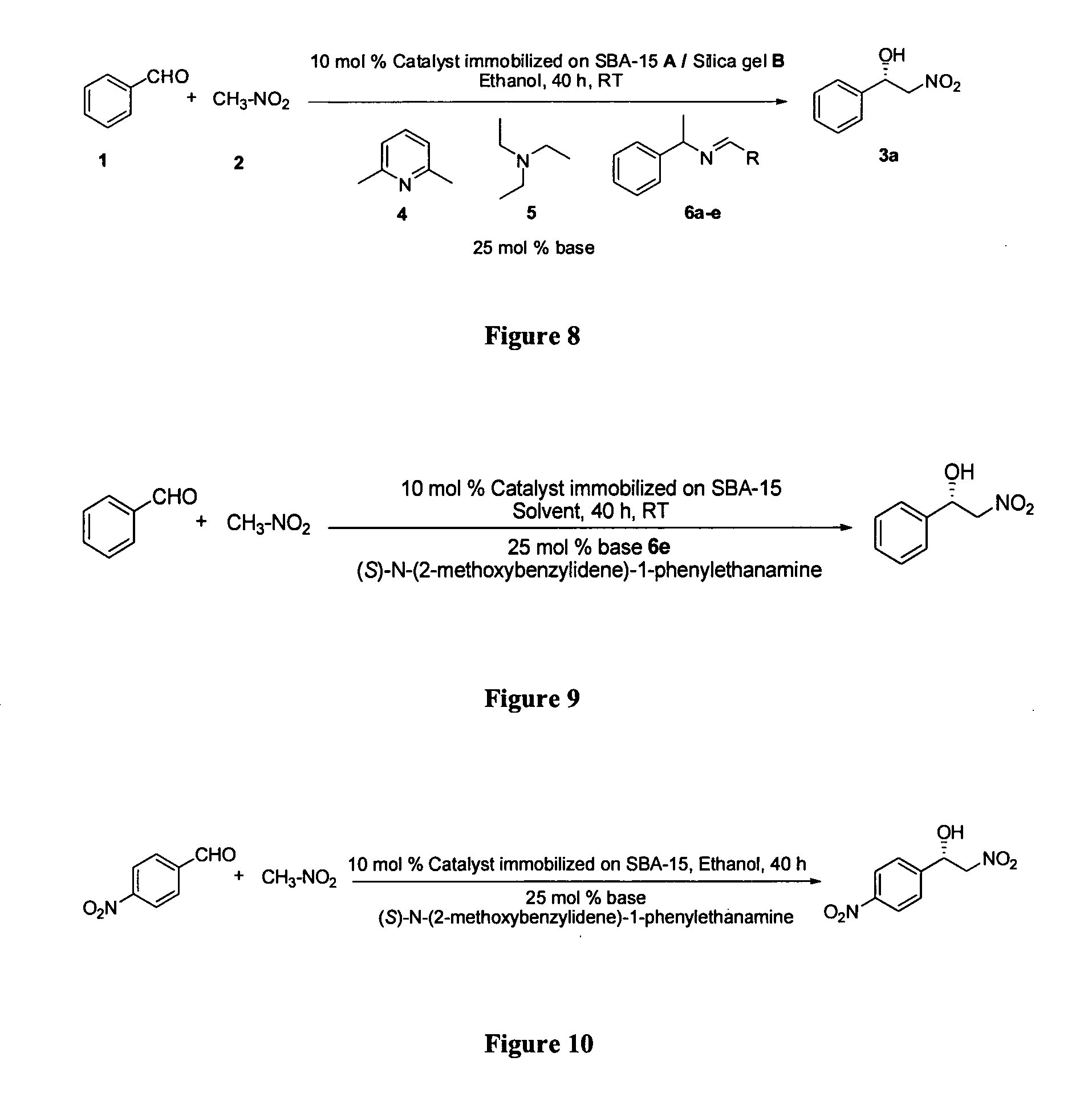Chiral Heterogeneous Catalyst for Assymmetric Nitroaldol Reaction
a nitroaldol and heterogeneous catalyst technology, applied in the direction of organic compounds/hydrides/coordination complex catalysts, physical/chemical process catalysts, organic chemistry, etc., can solve the problems of catalyst non-recyclability catalyst is non-recyclable, etc., to achieve high yield, without loss of final product yield, and enantioselectivity greater than 97%
- Summary
- Abstract
- Description
- Claims
- Application Information
AI Technical Summary
Benefits of technology
Problems solved by technology
Method used
Image
Examples
example 1
[0110]In a typical process for the preparation of novel asymmetric heterogeneous catalyst described in following Steps
Step 1
(2′S)—N-(2′,3′-epoxypropyl)-3-(aminopropyl)-triethoxysilane
[0111](S)-(+)-epichlorohydrin (2.557 mmol), 3-aminopropyl triethoxysilane (2.557 mmol), potassium carbonate (5.1 mmol) and dry tetrahydrofuran (10 ml) were charged in a 3-necked 50 ml round bottom flask equipped with a mechanical stirrer, addition funnel and a reflux condenser connected to a gas inlet. The resulting mixture was stirred at 30° C. for 10 minutes and followed by refluxing the mixture at 65° C. for 12 h under nitrogen atmosphere. The reaction mixture was filtered under an inert atmosphere. Solvent from the filtrate was removed by the dry nitrogen draft, Yield; (95%). LCMS: 278 [M+H]+, 302 [M+Na]+. 262, 216, 1H NMR (200 MHz, CDCl3): δ 0.63 (t, J=7.90, 2H), 1.22 (t, J=6.97, 3H), 1.48-1.63 (m, 2H), 1.85 (bs, NH), 2.67 (t, J=7.28, 2H), 2.77 (d, J=3.96, 1H), 2.82-2.88 (m, 1H), 3.55 (d, J=5.53, 1...
example 2
Step 1
(2′R)—N-(2′,3′-epoxypropyl)-3-(aminopropyl)-triethoxysilane
[0115](R)-(−)-epichlorohydrin (2.557 mmol), 3-aminopropyl triethoxysilane (2.557 mmol), potassium carbonate (5.1 mmol) and dry tetrahydrofuran (15 ml) were reacted and processed in the manner it was done in step 1 of the example 1, Yield (96%).
Step 2
(R)-aminopropyl epoxy-support-41
[0116]The product of step 1 (2.0 mmol) of this example was dissolved in 15 ml dry toluene in 3-necked 50 ml round bottom flask in an inert atmosphere. Then this dissolved mass was treated with MCM-41 (MCM-41: XRD, d100 3.48; BET surface area: 1064 m2 / g; Pore volume: 0.942 cm3 / g; BJH pore diameter: 35.4 Å) (2.0 g) for 48 h. at refluxing temperature at 110° C. The reaction mixture was processed as per the method given in step 2 of the example 1. Yield; (2.0 g, loading of amino-epoxy compound on MCM-41 was found to be 0.45 mmol / g).
Step 3
(R)-aminopropyl alcohol-support-41
[0117]The epoxy product from the step 2 (2.0 g) of this example was treated ...
example 3
Step 1
(2′S)—N-(2′,3′-epoxypropyl)-3-(aminopropyl)-trimethoxysilane
[0119](S)-(+)-epibromohydrin (2.557 mmol), 3-aminopropyl trimethoxy silane (2.557 mmol), potassium carbonate (5.1 mmol) and dry diethyl ether (10 ml) were charged in a 3-necked 50 ml round bottom flask equipped with a mechanical stirrer, addition funnel and a reflux condenser connected to a nitrogen inlet. The resulting mixture was stirred at 30° C. for 10 minutes and followed by refluxing the mixture at 35° C. for 10 h. The reaction mixture was filtered under inert atmosphere. Solvent from the filtrate was removed by the dry nitrogen draft, Yield; (95%). LCMS: 278 [M+H]+, 302 [M+Na]+. 262, 216, 1H NMR (200 MHz, CDCl3): δ 0.63 (t, J=7.90, 2H), 1.22 (t, J=6.97, 3H), 1.48-1.63 (m, 2H), 1.85 (bs, NH), 2.67 (t, J=7.28, 2H), 2.77 (d, J=3.96, 1H), 2.82-2.88 (m, 1H), 3.55 (d, J=5.53, 1H), 3.69 (q, J=6.93, 13.95, 2H), 3.82 (q, J=6.99, 13.93, 2H,); 13C NMR spectroscopy (50 MHz, CDCl3): δ (8.48, 18.86, 27.64, 45.47, 47.99, 52.6...
PUM
| Property | Measurement | Unit |
|---|---|---|
| Temperature | aaaaa | aaaaa |
| Temperature | aaaaa | aaaaa |
| Temperature | aaaaa | aaaaa |
Abstract
Description
Claims
Application Information
 Login to View More
Login to View More - R&D
- Intellectual Property
- Life Sciences
- Materials
- Tech Scout
- Unparalleled Data Quality
- Higher Quality Content
- 60% Fewer Hallucinations
Browse by: Latest US Patents, China's latest patents, Technical Efficacy Thesaurus, Application Domain, Technology Topic, Popular Technical Reports.
© 2025 PatSnap. All rights reserved.Legal|Privacy policy|Modern Slavery Act Transparency Statement|Sitemap|About US| Contact US: help@patsnap.com



